[English] 日本語
 Yorodumi
Yorodumi- PDB-7czl: Structural insights into a dimeric Psb27-photosystem II complex f... -
+ Open data
Open data
- Basic information
Basic information
| Entry | Database: PDB / ID: 7czl | ||||||||||||||||||||||||||||||
|---|---|---|---|---|---|---|---|---|---|---|---|---|---|---|---|---|---|---|---|---|---|---|---|---|---|---|---|---|---|---|---|
| Title | Structural insights into a dimeric Psb27-photosystem II complex from a cyanobacterium Thermosynechococcus vulcanus | ||||||||||||||||||||||||||||||
 Components Components |
| ||||||||||||||||||||||||||||||
 Keywords Keywords | PLANT PROTEIN / dimeric photosystem II (PSII)-Psb27 complex from a cyanobacterium Thermosynechococcus vulcanus | ||||||||||||||||||||||||||||||
| Function / homology |  Function and homology information Function and homology informationoxygen evolving activity / photosystem II stabilization / photosystem II reaction center / photosystem II / oxidoreductase activity, acting on diphenols and related substances as donors, oxygen as acceptor / photosynthetic electron transport chain / photosystem II / response to herbicide / chlorophyll binding / plasma membrane-derived thylakoid membrane ...oxygen evolving activity / photosystem II stabilization / photosystem II reaction center / photosystem II / oxidoreductase activity, acting on diphenols and related substances as donors, oxygen as acceptor / photosynthetic electron transport chain / photosystem II / response to herbicide / chlorophyll binding / plasma membrane-derived thylakoid membrane / photosynthetic electron transport in photosystem II / : / phosphate ion binding / photosynthesis, light reaction / photosynthesis / electron transfer activity / protein stabilization / iron ion binding / heme binding / metal ion binding Similarity search - Function | ||||||||||||||||||||||||||||||
| Biological species |  Thermosynechococcus vulcanus (bacteria) Thermosynechococcus vulcanus (bacteria) | ||||||||||||||||||||||||||||||
| Method | ELECTRON MICROSCOPY / single particle reconstruction / cryo EM / Resolution: 3.78 Å | ||||||||||||||||||||||||||||||
 Authors Authors | Pi, X. / Huang, G. / Xiao, Y. | ||||||||||||||||||||||||||||||
 Citation Citation |  Journal: Proc Natl Acad Sci U S A / Year: 2021 Journal: Proc Natl Acad Sci U S A / Year: 2021Title: Structural insights into a dimeric Psb27-photosystem II complex from a cyanobacterium . Authors: Guoqiang Huang / Yanan Xiao / Xiong Pi / Liang Zhao / Qingjun Zhu / Wenda Wang / Tingyun Kuang / Guangye Han / Sen-Fang Sui / Jian-Ren Shen /   Abstract: Photosystem II (PSII) is a multisubunit pigment-protein complex and catalyzes light-driven water oxidation, leading to the conversion of light energy into chemical energy and the release of molecular ...Photosystem II (PSII) is a multisubunit pigment-protein complex and catalyzes light-driven water oxidation, leading to the conversion of light energy into chemical energy and the release of molecular oxygen. Psb27 is a small thylakoid lumen-localized protein known to serve as an assembly factor for the biogenesis and repair of the PSII complex. The exact location and binding fashion of Psb27 in the intermediate PSII remain elusive. Here, we report the structure of a dimeric Psb27-PSII complex purified from a deletion mutant (ΔPsbV) of the cyanobacterium , solved by cryo-electron microscopy. Our structure showed that Psb27 is associated with CP43 at the luminal side, with specific interactions formed between Helix 2 and Helix 3 of Psb27 and a loop region between Helix 3 and Helix 4 of CP43 (loop C) as well as the large, lumen-exposed and hydrophilic E-loop of CP43. The binding of Psb27 imposes some conflicts with the N-terminal region of PsbO and also induces some conformational changes in CP43, CP47, and D2. This makes PsbO unable to bind in the Psb27-PSII. Conformational changes also occurred in D1, PsbE, PsbF, and PsbZ; this, together with the conformational changes occurred in CP43, CP47, and D2, may prevent the binding of PsbU and induce dissociation of PsbJ. This structural information provides important insights into the regulation mechanism of Psb27 in the biogenesis and repair of PSII. | ||||||||||||||||||||||||||||||
| History |
|
- Structure visualization
Structure visualization
| Movie |
 Movie viewer Movie viewer |
|---|---|
| Structure viewer | Molecule:  Molmil Molmil Jmol/JSmol Jmol/JSmol |
- Downloads & links
Downloads & links
- Download
Download
| PDBx/mmCIF format |  7czl.cif.gz 7czl.cif.gz | 1.1 MB | Display |  PDBx/mmCIF format PDBx/mmCIF format |
|---|---|---|---|---|
| PDB format |  pdb7czl.ent.gz pdb7czl.ent.gz | 907.2 KB | Display |  PDB format PDB format |
| PDBx/mmJSON format |  7czl.json.gz 7czl.json.gz | Tree view |  PDBx/mmJSON format PDBx/mmJSON format | |
| Others |  Other downloads Other downloads |
-Validation report
| Arichive directory |  https://data.pdbj.org/pub/pdb/validation_reports/cz/7czl https://data.pdbj.org/pub/pdb/validation_reports/cz/7czl ftp://data.pdbj.org/pub/pdb/validation_reports/cz/7czl ftp://data.pdbj.org/pub/pdb/validation_reports/cz/7czl | HTTPS FTP |
|---|
-Related structure data
| Related structure data |  30511MC M: map data used to model this data C: citing same article ( |
|---|---|
| Similar structure data |
- Links
Links
- Assembly
Assembly
| Deposited unit | 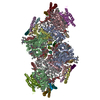
|
|---|---|
| 1 |
|
- Components
Components
-Photosystem II ... , 13 types, 26 molecules AaBbCcDdHhIiKkLlMmTtZzYyXx
| #1: Protein | Mass: 35894.949 Da / Num. of mol.: 2 / Source method: isolated from a natural source / Source: (natural)  Thermosynechococcus vulcanus (bacteria) / References: UniProt: P51765, photosystem II Thermosynechococcus vulcanus (bacteria) / References: UniProt: P51765, photosystem II#2: Protein | Mass: 56096.758 Da / Num. of mol.: 2 / Source method: isolated from a natural source / Source: (natural)  Thermosynechococcus vulcanus (bacteria) / References: UniProt: D0VWR1 Thermosynechococcus vulcanus (bacteria) / References: UniProt: D0VWR1#3: Protein | Mass: 48648.688 Da / Num. of mol.: 2 / Source method: isolated from a natural source / Source: (natural)  Thermosynechococcus vulcanus (bacteria) / References: UniProt: D0VWR7 Thermosynechococcus vulcanus (bacteria) / References: UniProt: D0VWR7#4: Protein | Mass: 38005.484 Da / Num. of mol.: 2 / Source method: isolated from a natural source / Source: (natural)  Thermosynechococcus vulcanus (bacteria) / References: UniProt: D0VWR8, photosystem II Thermosynechococcus vulcanus (bacteria) / References: UniProt: D0VWR8, photosystem II#7: Protein | Mass: 6986.271 Da / Num. of mol.: 2 / Source method: isolated from a natural source / Source: (natural)  Thermosynechococcus vulcanus (bacteria) / References: UniProt: P19052 Thermosynechococcus vulcanus (bacteria) / References: UniProt: P19052#8: Protein/peptide | Mass: 3923.706 Da / Num. of mol.: 2 / Source method: isolated from a natural source / Source: (natural)  Thermosynechococcus vulcanus (bacteria) / References: UniProt: P12240 Thermosynechococcus vulcanus (bacteria) / References: UniProt: P12240#9: Protein/peptide | Mass: 4101.911 Da / Num. of mol.: 2 / Source method: isolated from a natural source / Source: (natural)  Thermosynechococcus vulcanus (bacteria) / References: UniProt: P19054 Thermosynechococcus vulcanus (bacteria) / References: UniProt: P19054#10: Protein/peptide | Mass: 4299.044 Da / Num. of mol.: 2 / Source method: isolated from a natural source / Source: (natural)  Thermosynechococcus vulcanus (bacteria) / References: UniProt: P12241 Thermosynechococcus vulcanus (bacteria) / References: UniProt: P12241#11: Protein/peptide | Mass: 3678.338 Da / Num. of mol.: 2 / Source method: isolated from a natural source / Source: (natural)  Thermosynechococcus vulcanus (bacteria) / References: UniProt: P12312 Thermosynechococcus vulcanus (bacteria) / References: UniProt: P12312#12: Protein/peptide | Mass: 3620.369 Da / Num. of mol.: 2 / Source method: isolated from a natural source / Source: (natural)  Thermosynechococcus vulcanus (bacteria) / References: UniProt: P12313 Thermosynechococcus vulcanus (bacteria) / References: UniProt: P12313#13: Protein | Mass: 6766.187 Da / Num. of mol.: 2 / Source method: isolated from a natural source / Source: (natural)  Thermosynechococcus vulcanus (bacteria) / References: UniProt: D0VWR5 Thermosynechococcus vulcanus (bacteria) / References: UniProt: D0VWR5#14: Protein/peptide | Mass: 3228.035 Da / Num. of mol.: 2 / Source method: isolated from a natural source / Source: (natural)  Thermosynechococcus vulcanus (bacteria) / References: UniProt: D0VWR3 Thermosynechococcus vulcanus (bacteria) / References: UniProt: D0VWR3#16: Protein/peptide | Mass: 4191.030 Da / Num. of mol.: 2 / Source method: isolated from a natural source / Source: (natural)  Thermosynechococcus vulcanus (bacteria) / References: UniProt: D0VWR4 Thermosynechococcus vulcanus (bacteria) / References: UniProt: D0VWR4 |
|---|
-Cytochrome b559 subunit ... , 2 types, 4 molecules EeFf
| #5: Protein | Mass: 7495.497 Da / Num. of mol.: 2 / Source method: isolated from a natural source / Source: (natural)  Thermosynechococcus vulcanus (bacteria) / References: UniProt: P12238 Thermosynechococcus vulcanus (bacteria) / References: UniProt: P12238#6: Protein/peptide | Mass: 3461.166 Da / Num. of mol.: 2 / Source method: isolated from a natural source / Source: (natural)  Thermosynechococcus vulcanus (bacteria) / References: UniProt: P12239 Thermosynechococcus vulcanus (bacteria) / References: UniProt: P12239 |
|---|
-Protein , 1 types, 2 molecules nN
| #15: Protein | Mass: 12234.814 Da / Num. of mol.: 2 / Source method: isolated from a natural source / Source: (natural)  Thermosynechococcus vulcanus (bacteria) Thermosynechococcus vulcanus (bacteria) |
|---|
-Sugars , 2 types, 14 molecules 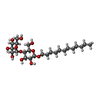


| #22: Sugar | ChemComp-LMT / #26: Sugar | ChemComp-DGD / |
|---|
-Non-polymers , 12 types, 132 molecules 

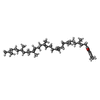



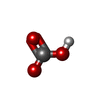
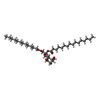















| #17: Chemical | ChemComp-CLA / #18: Chemical | ChemComp-PHO / #19: Chemical | ChemComp-PQ9 / #20: Chemical | ChemComp-BCR / #21: Chemical | #23: Chemical | ChemComp-SQD / #24: Chemical | #25: Chemical | ChemComp-MGE / ( #27: Chemical | #28: Chemical | #29: Chemical | #30: Chemical | |
|---|
-Details
| Has ligand of interest | Y |
|---|---|
| Has protein modification | N |
-Experimental details
-Experiment
| Experiment | Method: ELECTRON MICROSCOPY |
|---|---|
| EM experiment | Aggregation state: PARTICLE / 3D reconstruction method: single particle reconstruction |
- Sample preparation
Sample preparation
| Component | Name: PSII-Psb27 / Type: COMPLEX / Entity ID: #1-#16 / Source: NATURAL |
|---|---|
| Source (natural) | Organism:  Thermosynechococcus vulcanus (bacteria) Thermosynechococcus vulcanus (bacteria) |
| Buffer solution | pH: 6 |
| Specimen | Embedding applied: NO / Shadowing applied: NO / Staining applied: NO / Vitrification applied: YES |
| Vitrification | Cryogen name: ETHANE |
- Electron microscopy imaging
Electron microscopy imaging
| Experimental equipment |  Model: Titan Krios / Image courtesy: FEI Company |
|---|---|
| Microscopy | Model: FEI TITAN KRIOS |
| Electron gun | Electron source:  FIELD EMISSION GUN / Accelerating voltage: 300 kV / Illumination mode: FLOOD BEAM FIELD EMISSION GUN / Accelerating voltage: 300 kV / Illumination mode: FLOOD BEAM |
| Electron lens | Mode: BRIGHT FIELD |
| Image recording | Electron dose: 50 e/Å2 / Film or detector model: GATAN K2 SUMMIT (4k x 4k) |
- Processing
Processing
| Software | Name: PHENIX / Version: 1.10.1_2155: / Classification: refinement | ||||||||||||||||||||||||
|---|---|---|---|---|---|---|---|---|---|---|---|---|---|---|---|---|---|---|---|---|---|---|---|---|---|
| EM software | Name: PHENIX / Category: model refinement | ||||||||||||||||||||||||
| CTF correction | Type: NONE | ||||||||||||||||||||||||
| 3D reconstruction | Resolution: 3.78 Å / Resolution method: FSC 0.143 CUT-OFF / Num. of particles: 87473 / Symmetry type: POINT | ||||||||||||||||||||||||
| Refine LS restraints |
|
 Movie
Movie Controller
Controller




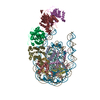
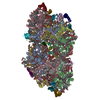


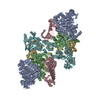

 PDBj
PDBj























